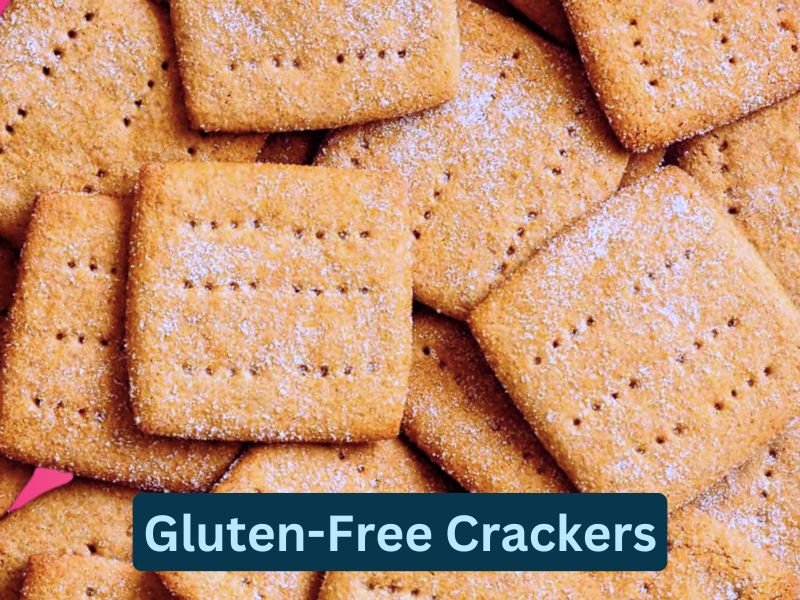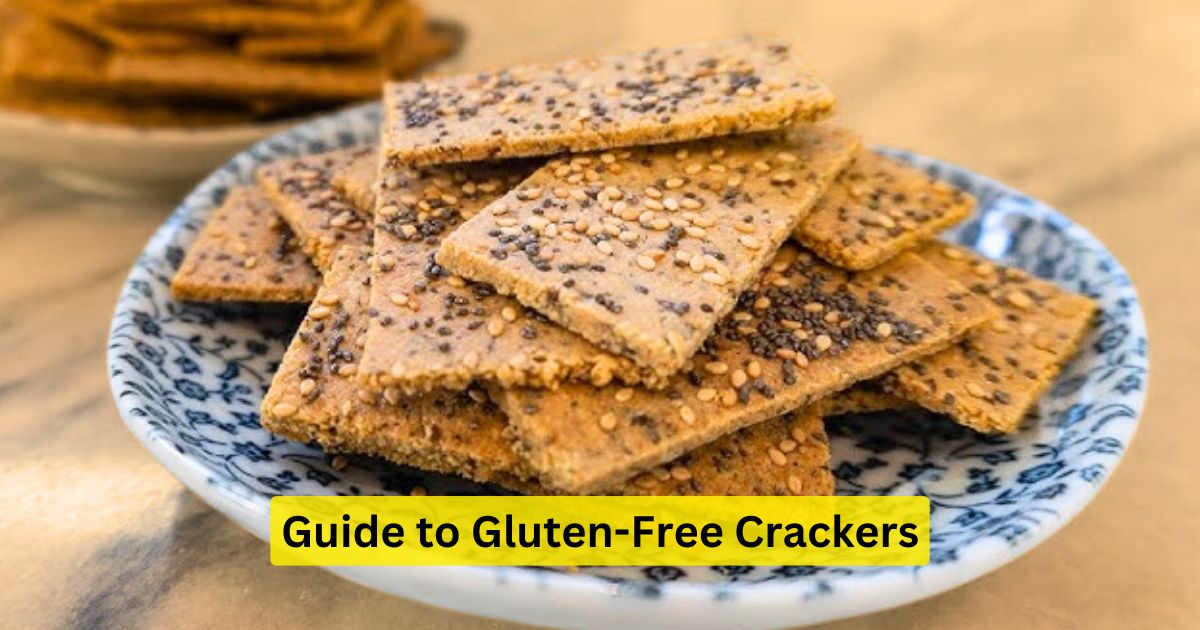What Are Gluten-Free Crackers?
Gluten-free crackers are a staple snack for individuals who avoid gluten due to celiac disease, gluten intolerance, or a general health preference. These crackers are made from alternative flours such as almond, rice, quinoa, or cassava, making them safe and delicious options for gluten-free diets. With a growing demand for gluten-free products, manufacturers now produce crackers in various flavors and textures, catering to a diverse range of palates.
Choosing gluten-free crackers offers a safer snacking option, especially for those who are vigilant about hidden sources of gluten in everyday foods. These snacks are also versatile, pairing wonderfully with dips, cheeses, and even as a base for appetizers.
For more on snack options and dietary tips, explore our Celiac Disease Guide to discover gluten-free living essentials.
Why Choose Gluten-Free Crackers?

Opting for gluten-free crackers is not just about avoiding gluten but also about embracing healthier ingredients and broader dietary benefits. These crackers often feature nutrient-dense components like seeds, nuts, and whole grains that provide a richer nutritional profile compared to traditional wheat-based snacks.
Benefits of Gluten-Free Crackers:
- Nutritional Advantages: Many are rich in fiber, omega-3 fatty acids, and protein due to ingredients like chia seeds and almond flour.
- Safe for Multiple Diets: Gluten-free crackers are often compatible with other diets such as vegan, paleo, and dairy-free.
- Reduced Risk of Allergies: By eliminating wheat and common allergens, these crackers are safer for sensitive individuals.
For those just starting their journey, exploring a living gluten-free lifestyle can help you incorporate snacks like gluten-free crackers more effectively. Visit our guide on Living Gluten-Free for practical tips.
Top Ingredients in Gluten-Free Crackers
The key to making or choosing the best gluten-free crackers lies in understanding their ingredients. Gluten-free crackers are often crafted from high-quality flours and seeds that ensure a crisp texture and robust flavor while keeping them entirely gluten-free.
Common Ingredients:
- Almond Flour: A popular base for crackers, offering a nutty flavor and high protein content.
- Rice Flour: A light and neutral-tasting option perfect for achieving a classic cracker texture.
- Cassava Flour: Made from yuca root, it’s a starchy, grain-free flour that adds elasticity.
- Chia and Flaxseeds: These seeds boost fiber and omega-3s, making crackers more nutritious.
- Quinoa Flour: Provides a slightly nutty flavor and is packed with essential nutrients.
For a deeper understanding of gluten-free flours, check out our Gluten-Free Flour Alternatives to learn how these ingredients can be incorporated into a gluten-free diet.es.
Best Brands of Gluten-Free Crackers
The market for gluten-free crackers has expanded significantly, offering a variety of options tailored to different tastes, textures, and dietary needs. Choosing the right brand can make all the difference in enjoying a safe and delicious snack.
1. Simple Mills
- Known for its almond flour-based crackers, Simple Mills offers a clean ingredient list free from artificial additives. Their crackers are a perfect choice for pairing with hummus or cheese.
2. Mary’s Gone Crackers
- These seed-based crackers are organic and gluten-free, providing a hearty crunch and a healthy dose of fiber. They’re ideal for those who prefer nutrient-dense options.
3. Crunchmaster
- Crafted with brown rice, quinoa, and sesame seeds, Crunchmaster crackers are light yet satisfying. Their multi-grain options are certified gluten-free, making them a trusted choice for families.
4. Blue Diamond Nut-Thins
- Combining almonds and rice flour, Blue Diamond Nut-Thins are light and crispy, offering a subtle nutty flavor that pairs well with spreads or dips.
To learn more about trusted gluten-free products, explore our Celiac Disease Basics for helpful shopping tips.
How to Make Gluten-Free Crackers at Home
Making gluten-free crackers at home is a simple and rewarding process. With a few pantry staples and some creativity, you can craft crackers that suit your specific dietary needs and flavor preferences.
Basic Gluten-Free Cracker Recipe
Ingredients:
- 1 cup almond flour
- 1/4 cup tapioca starch
- 2 tablespoons flaxseeds (optional)
- 1/2 teaspoon salt
- 2 tablespoons olive oil
- 3–4 tablespoons water
Instructions:
- Mix the Dry Ingredients: In a mixing bowl, combine almond flour, tapioca starch, flaxseeds, and salt.
- Add Liquids: Stir in olive oil and water until a dough forms. Add water gradually to avoid over-moistening.
- Roll Out the Dough: Place the dough between two sheets of parchment paper and roll it to about 1/8-inch thickness.
- Cut and Shape: Use a knife or cookie cutter to create your desired cracker shapes.
- Bake: Transfer to a baking sheet and bake at 350°F (175°C) for 12–15 minutes or until golden brown.
- Cool and Store: Allow the crackers to cool completely before storing them in an airtight container.
For more tips on preparing gluten-free recipes safely, visit: Are Grits Gluten-Free.
Creative Gluten-Free Cracker Recipes
Gluten-free crackers aren’t just a standalone snack—they can be transformed into gourmet appetizers, side dishes, or even dessert bases. Here are a few creative recipes to inspire your next meal or gathering.
1. Herb-Infused Crackers
- Ingredients: Almond flour, olive oil, fresh rosemary, and garlic powder.
- Instructions: Add finely chopped rosemary and garlic powder to the dough for a fragrant twist. Perfect for pairing with cheese or hummus.
2. Cheddar Cheese Crackers
- Ingredients: Almond flour, shredded cheddar, and a pinch of paprika.
- Instructions: Incorporate cheddar into the dough and sprinkle paprika on top before baking. These are great for kids or as a side to soup.
3. Seeded Crackers
- Ingredients: A mix of chia seeds, flaxseeds, sesame seeds, and quinoa.
- Instructions: Combine the seeds into the dough for a nutrient-dense cracker that pairs wonderfully with avocado or smoked salmon.
For additional inspiration, check out our guide on Ultimate Guide to Gluten-Free Living to enhance your gluten-free cooking repertoire.
Nutritional Benefits of Gluten-Free Crackers
Gluten-free crackers are more than just a safe snack option for those with celiac disease or gluten intolerance—they also offer significant nutritional benefits due to the high-quality ingredients they often contain. Let’s break down why these crackers are a healthier choice compared to their traditional counterparts.
Rich in Fiber
Many gluten-free crackers incorporate whole grains and seeds like quinoa, chia, and flaxseeds, which are excellent sources of dietary fiber. Fiber promotes healthy digestion, helps control blood sugar levels, and supports a healthy weight by keeping you full longer.
High in Protein
Ingredients like almond flour, chickpea flour, and quinoa are naturally high in protein. Protein is essential for muscle repair, immune function, and sustained energy, making these crackers a smart choice for active individuals or as a post-workout snack.
Packed with Healthy Fats
Some gluten-free crackers use seeds, nuts, and coconut oil in their recipes, which contribute to healthy fats. These fats are beneficial for brain health, energy, and overall wellness.
Lower in Refined Carbs
Unlike traditional crackers made with refined wheat flour, gluten-free crackers often use whole grain or nut-based flours. This lowers the glycemic index of the snack, helping to avoid rapid blood sugar spikes and crashes.
To learn more about the role of gluten-free snacks in a healthy diet, visit our Celiac Disease Diagnosis for expert dietary advice.
Pairing Gluten-Free Crackers with Dips and Toppings
Gluten-free crackers can be transformed into a gourmet delight when paired with the right dips and toppings. Whether you’re hosting a party or enjoying a quiet snack, the possibilities are endless.
Delicious Dips:
- Hummus: The creamy texture and rich flavor of hummus pair perfectly with seeded crackers.
- Guacamole: Made with fresh avocado, lime, and garlic, guacamole adds a zesty flair to plain crackers.
- Gluten-Free Spinach Artichoke Dip: This indulgent dip complements the crunchy texture of almond or rice flour-based crackers.
Tasty Toppings:
- Cheese: Sharp cheddar, creamy brie, or tangy goat cheese are all excellent options for gluten-free crackers.
- Smoked Salmon: A luxurious topping that pairs well with plain or herb-infused crackers.
- Nut Butters: Almond or peanut butter adds a sweet-savory twist, especially on lightly salted crackers.
For a deeper dive into gluten-free dining options, explore our Are Rice Krispies Gluten-Free guide for complementary snack ideas.
How to Avoid Cross-Contamination with Gluten-Free Crackers
Cross-contamination is one of the biggest challenges for individuals with celiac disease or severe gluten sensitivity. Even gluten-free crackers can become unsafe if they come into contact with gluten-containing foods or surfaces during preparation, packaging, or storage. Here’s how to prevent cross-contamination and ensure your crackers remain safe to eat.
Tips for Preventing Cross-Contamination:
- Check the Label: Always choose crackers labeled “certified gluten-free.” This certification ensures that the product has been manufactured in a gluten-free facility and tested for contamination.
- Store Separately: Keep gluten-free crackers in a designated area of your pantry, away from gluten-containing products. Use clearly labeled containers to avoid mix-ups.
- Use Dedicated Tools: When preparing gluten-free snacks, use separate utensils, cutting boards, and serving platters to prevent cross-contact.
- Communicate at Events: If serving gluten-free crackers at a gathering, label them clearly and avoid placing them near gluten-containing foods to reduce the risk of accidental contamination.
For more on maintaining a safe gluten-free kitchen, visit our Celiac Disease Basics guide.
Where to Buy the Best Gluten-Free Crackers
Finding high-quality gluten-free crackers has never been easier, thanks to the growing demand for gluten-free products. Whether you’re shopping at a local grocery store or browsing online, here’s where to look for the best options.
Local Grocery Stores
Many major supermarkets now feature a dedicated gluten-free section stocked with various cracker brands. Look for brands like Simple Mills, Mary’s Gone Crackers, and Crunchmaster, which are widely available and trusted by gluten-free consumers.
Specialty Health Food Stores
Stores like Whole Foods, Sprouts, and Trader Joe’s carry premium gluten-free products. These retailers often stock unique brands and flavors that you won’t find at regular grocery stores.
Online Retailers
Shopping online offers convenience and access to a broader selection of gluten-free crackers. Websites like Amazon and Thrive Market carry popular brands, and many manufacturers, such as Blue Diamond, sell directly through their online stores. Buying online also allows you to read reviews and compare prices before making a purchase.
For more advice on sourcing gluten-free foods, check out our Ultimate Guide to Gluten-Free Living.
Storing Gluten-Free Crackers Properly
Proper storage is essential to maintain the freshness, flavor, and safety of gluten-free crackers. Since these crackers are often made with alternative flours and fewer preservatives, they may have a shorter shelf life than traditional crackers.
Storage Tips:
- Airtight Containers: Transfer crackers to an airtight container after opening to keep them fresh and prevent exposure to humidity.
- Cool, Dry Place: Store crackers in a cool, dry pantry away from direct sunlight, which can cause oils in the crackers to go rancid.
- Freezing: Some gluten-free crackers, especially homemade ones, can be frozen to extend their shelf life. Place them in a freezer-safe bag or container, and thaw at room temperature before serving.
By following these tips, you can enjoy your gluten-free crackers at their best for longer.
Conclusion
Gluten-free crackers are a versatile and essential option for anyone following a gluten-free diet. Whether you’re looking for a quick snack, a base for creative appetizers, or a nutrient-dense alternative to traditional crackers, these gluten-free options have you covered. From choosing top-rated brands to making your own at home, there are endless ways to enjoy these crispy, flavorful treats.
With the tips and insights provided in this guide, you can confidently select and prepare gluten-free crackers that suit your taste and dietary needs. Whether you prefer store-bought varieties or homemade recipes, these crackers make it easy to snack without sacrificing health or flavor.
For more inspiration and resources on gluten-free living, explore: Living Gluten-Free
FAQs
- What flours are commonly used in gluten-free crackers?
Almond flour, rice flour, and tapioca starch are popular choices. - Are gluten-free crackers healthier than regular crackers?
They can be, as they often contain nutrient-dense ingredients like seeds. - Can I make gluten-free crackers without a food processor?
Yes, you can mix the dough manually and roll it out with ease. - Do gluten-free crackers taste different?
Gluten-free crackers can taste slightly nuttier or grainier depending on the ingredients. - How do I ensure my crackers are certified gluten-free?
Look for the “certified gluten-free” label on the packaging. - Are all gluten-free crackers vegan?
Not always; some contain dairy or eggs, so check the label. - What are the best stores to buy gluten-free crackers?
Specialty health food stores and online retailers like Amazon carry a wide variety.

Hi, I’m Philip John – a writer at Celiac Magazine with a passion for uncovering the truth behind what we eat and how it affects our health. I dive deep into food science, nutrition, and living well with celiac disease, all with one goal: to make complex topics easy to understand and actionable. Whether you’re newly diagnosed or just curious about gluten-free living, I’m here to help you navigate it all with clarity and confidence.

